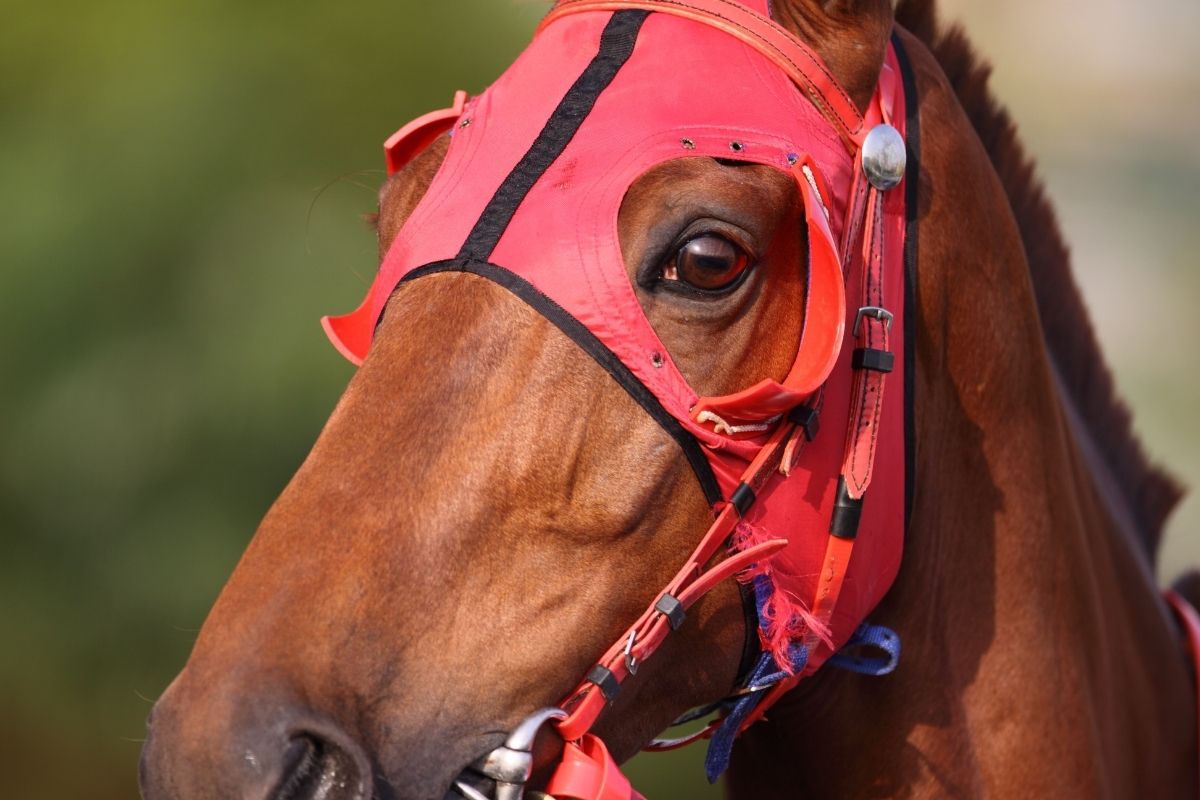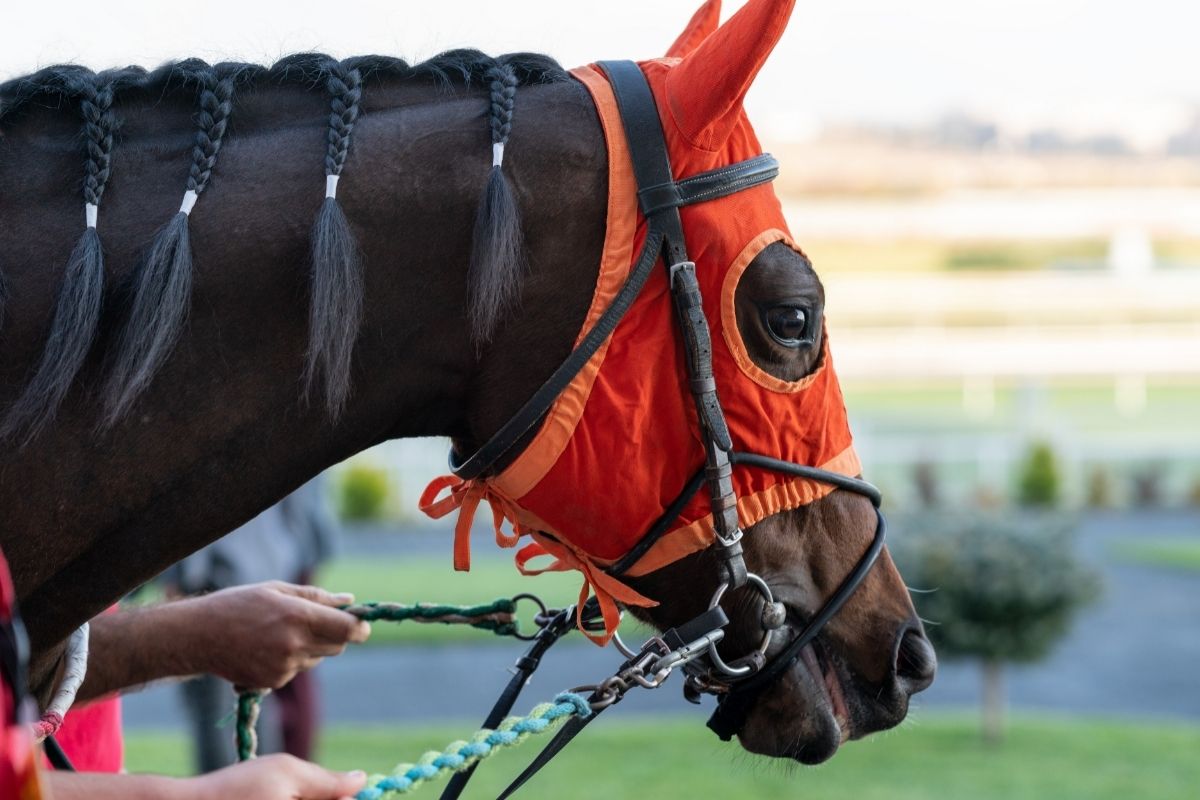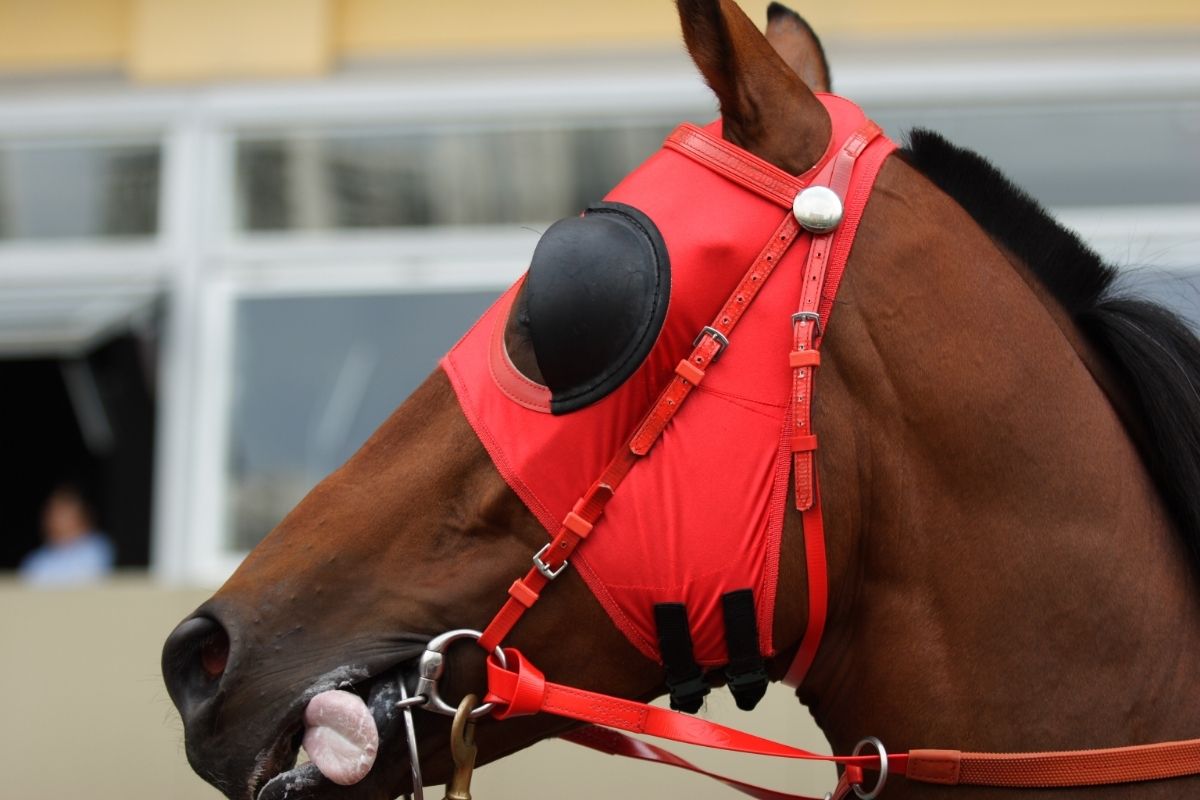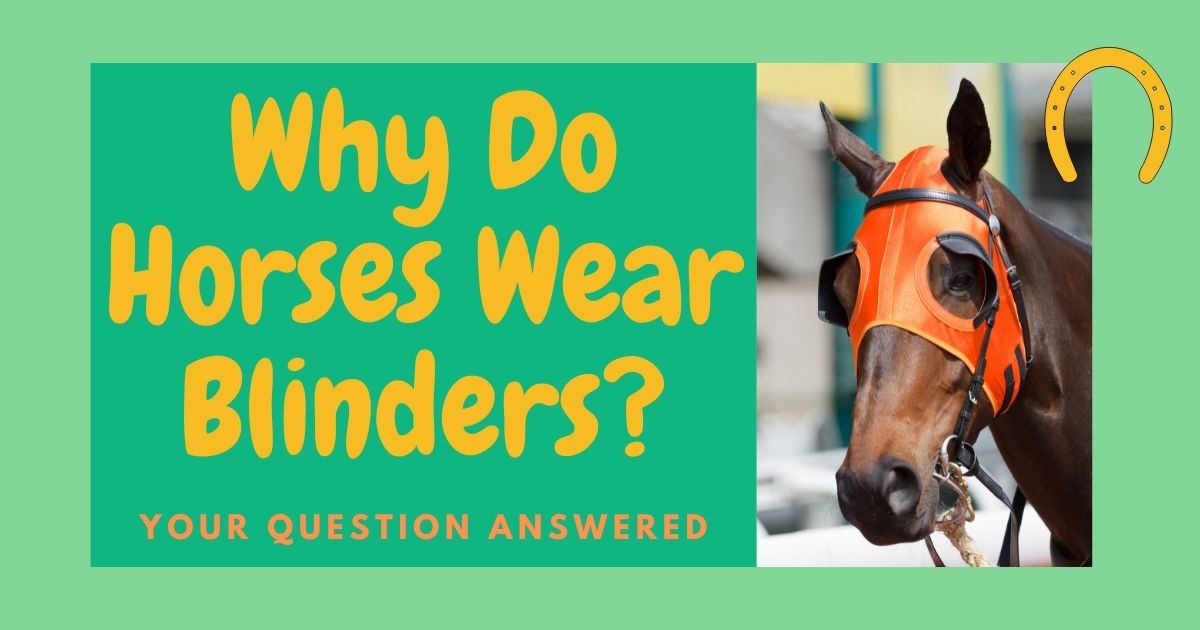What are Horse Blinders?
You may be wondering, “what are horse blinders, and why do horses wear blinders?”
Blinders restrict the horse’s vision only to see ahead of them. There are different types of blinders. You can make them using leather or plastic. Some people call blinders “winkers” or “blinkers.” Additionally, you can fit horse blinders on the horse’s bridle or halter or onto a hood.

Why Do Horses Wear Blinders?
During Carriage-Pulling
Horses wear blinders when pulling a carriage. This is because it can be hazardous if any visual information distracts them.
Horses often pull carriages in popular places with tourists, where they’re a big draw. But that can also mean that they work in places full of people and traffic. When you visit cities like New York and New Orleans, you’ll see a lot of horse-driven carriages.
A horse needs to pull a carriage to stay on task. If something startles it, it could very quickly run away. That would be very dangerous for both the horse and its people.
Many horses also work in pairs to pull carriages, and they’re always curious about new things. There is a good chance that their partner will be a distraction. And if they fight with their neighbor in the harness, which can happen, things can quickly get worse.
As long as your horse wears a horse blinder, you can avoid all of those problems. You will not have to worry about your horse getting dangerously distracted because they will focus on what is ahead of them. That also helps the horse move straight forward, so it doesn’t bump into any other horse that pairs with it.
For Draft Work
Many of the same rules apply to horses that do draft work, like plowing or other farm work. Horses often pair up with each other when they work with a plow. So, if horses are interested in their neighbors, that can be enough to keep them from working on their jobs!
Putting a plow or cart behind the animal can also make them look like a predator. Some people think that horses pulling a plow are less stimulated than horses pulling a carriage in the city, but this isn’t always the case.
But there’s still the chance that other animals, machines, or even shadows could get in the way. Keeping the horse focused is essential for safety with carrying heavy farm equipment.
In this case, blinders are a simple way to do just that. Because the horse has a narrow field of vision, the chances of being startled by sudden movements are minimal. It is common for people who ride draft horses to use leather blinders. They typically attach to the animal’s head with a piece of rope called a “halter.”
During a Race
A horse racing track is full of excitement. A jockey, a crowd, and a commentator are all in the picture. This is a horse race. And there are a lot of horses racing each other!
Because it’s full of danger, the horses will be galloping at a very high rate of speed soon. They might be hopping over fences to get to the other side. If they make a mistake, the consequences can be horrible for their riders, other horses, and people watching.
Even death can happen. People who look around can lose time in the race. Keeping the horse as calm and focused as possible in the middle of all the chaos is essential. In the United States, blinders for horses help with this kind of situation.
When a horse wears a hood, the cups are usually plastic and sewn to the hood. It all depends on how they look like. They can cut the animal’s field of vision by anywhere from 86 to 356 Fahrenheit (30 to 180 degrees Celsius).
The trainer and jockey will decide whether or not to put blinders on horses. They will be the ones who know the horse best. Some horses are very good at what they do, but that doesn’t always happen.
Research has shown that the most restrictive blinders for horses can make some of them feel like they are in a small space. At the start of a race, they might speed up to get out of the situation. These people won’t last long. They’ll lose ground as they run farther. In racing, You can use many blinders for different situations.
During racing, horses wear horse racing blinders as part of their headpiece. With plastic eye cups connected, you can make it with nylon, and the horse wears it over its head like a headband. The cups are available in a range of shapes and sizes. You can always find one that suits each horse. Here are a few examples of popular designs:
- Blinder with an extension cup or a full cup: Completely enclosed cup blinkers are the most restrictive, and horses typically wear them on only one side of the facemask. Horses who tend to stray to the outside of a track when running can benefit from this technique. Whenever it is necessary to keep a horse from wandering, you can make sure that it wears a full cup blinker on the outside eye of the mask.
- Standard blinkers: Standard blinkers are 2/3 cups with a hole in the middle of them. Because of the hole in the side, this type of blinker reduces a horse’s eyesight, but it still allows them to see other horses closing in on them. It is the most commonly encountered type of blinder.
- Semi-cup: A semi-cup is less restricted but not as open as the French cup gets compared to the regular blinker. Semi-cups are available in both black and white. You can always select one that is best for your horse.
- French cup: The French cup blinder is not a cup but rather a piece of plastic that stretches straight out from the mask. You can use the French cup to keep the horse’s eyes off the jockey when racing. In some races, racehorses anticipate the jockeys’ whip and lose concentration throughout the race; French cups help to combat this situation.
- Cheater cups: In comparison to other types of blinkers, cheater cups are the smallest, with virtually any cup at all. They simply obscure a small portion of vision and may have a more psychological purpose than an actual physical one in some situations. It serves as a gentle reminder that the race is approaching.
- No-blinkers mask: A mask with no blinkers gets worn by a horse to calm them down or soften the surrounding noise. Some people call a hood with no blinder cups Batman masks.
- Customized horses blinders: Because each horse is unique, it may require a specialized cup to function at its best. If this is the case, trainers may typically customize a pair of blinkers to match the same subtlety that a horse exhibits.
To Help Injured Eyes Heal
In some cases, You can use blinders to help a horse that has lost sight. Light can worsen some eye problems, so horses that wear more restrictive blinders can protect their eyes.
As simple as rubbing against a tree can do more harm than good to a horse with hurt eyes. People who wear masks like this can protect their eyes from scratches and abrasions by wearing masks that have strong cups.

Can Horses See Through Fly Masks?
Horses can indeed see well enough through a fly mask, but the mask makes it hard for them to tell how far away things are. When your horse is going to graze, You should only use fly masks. This is because your horse doesn’t need to be completely alert or engaged at all times.
Your horse can’t see as well without a fly mask on. Remove the fly mask each night. It also doesn’t make sense to wear a face mask at night because flies and other bugs aren’t as active. Even when your horse is inside or in an area where flies aren’t a problem, you should remove their fly mask to keep them from getting stung.
You should not ride or drive your horse while having a fly mask on. Many fly masks change your horse’s vision and sense of depth, which can be dangerous to both you and your horse.
In case your horse is getting bitten by flies while you are riding, you might want to think about getting them an insect-proof helmet. They aren’t as solid or protective as traditional fly masks, but they add an extra layer of protection to keep you safe from bugs.
When is a Blinder NOT a Blinder?
We’ve seen that horses can wear eye blinders in many places. There is usually a time when they have to pay attention to what they’re doing – like draft work, drawing a carriage, or even racing. Even if they’re standing in a field, you might see them wearing masks.
If the horse doesn’t have bad eyes, what you’re seeing isn’t a blinder but a fly mask instead. You might think that these masks protect your horse from being bothered by flies because of their name. You’re right.
It’s not just about getting rid of an annoyance. Some bugs can be very bad for a horse’s health. Additionally, mosquitoes and other blood-sucking insects can cause your horse pain and stress. This is how nature protects horses from this.
They have a lot of mane and forelock to keep them safe. Not every horse has these. Some horses are very sensitive to bites, so they need extra protection. A mask may look like it stops the horse from seeing, but that’s not true. It comes from mesh material, which lets the horse see through it.
A horse should wear a mask when feeding, but riding versions are also available whenever you want to use them. These fit more closely over the horse’s face and make it easier for people to see. But they aren’t as strong as other fly masks, and the horse shouldn’t wear them all the time, either.
How to Fit a Horse for a Fly Mask
Make sure you pick the suitable fly mask that fits your horse well. Selecting a mask that doesn’t fit your horse correctly can be disappointing. A mask that fits makes your horse very comfortable at all times. Here are some things to keep in mind when you buy one for your horse:
- Check out what they use to make the mask. It must be very smooth and not have any rough edges. Remember, anything that comes into contact with your horse’s face should be soft.
- Pay attention to the fit. When you put the mask on your horse, you want it to lay flat against its face.
- You should lower the edge. The bottom should be at least an inch (2.5 centimeters) below the horse’s cheekbone. If it ends too high, there will be a space to let flying bugs in. Then, keep in mind that you should be able to slip a finger between your horse’s face and the mask. The skin will get sores if it’s too tight.
- Make sure that the mask doesn’t get in the way of your horse’s eyes when it’s on. It mustn’t touch any part of the horse’s body, not even their eyelashes. If it does, there could be an infection, and it could be in the eye. Take a look from every angle, and make sure that your horse’s head can move up and down.
- Finally, be ready to try out different types of masks based on how your horse reacts to them. They will be less likely to get bugs if they have more of their face covered by the bug spray. However, some horses don’t like having a full mask and will do everything to get it off. That might be a good idea.
- If you live in an area where midges and gnats are a problem, you might want to wear a mask that protects your ears. Again, it will depend on how the horse responds to what you do. Some people don’t like ear coverings, and they’ll make quick work of a mask that has them.

Key Highlights
In our opinion, most horses are more at ease when they have some eye blinders on. They let the horse focus on the job at hand and not have to worry about the carriage moving around in their predator-warning vision to do their best work. On the other hand, some horses want to know everything they can about the world around them.
Each of these horses will work more confidently and comfortably with the equipment they like best. It’s your job to know how your horse feels. In this case, don’t worry too much about getting eye blinders on your horse. Let them be at ease. As always, make it safe and fun for you and your horse.
